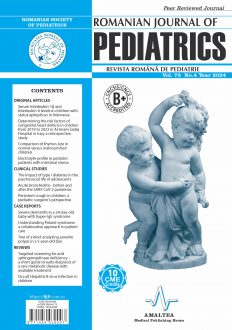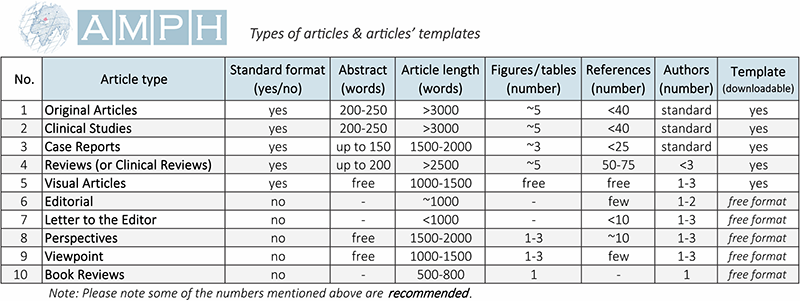SELECT ISSUE

Indexed

| |

|
|
|
| |
|
|
|

|
|
|
|
|
|
|
HIGHLIGHTS
National Awards “Science and Research”
NEW! RJP has announced the annually National Award for "Science and Research" for the best scientific articles published throughout the year in the official journal.
Read the Recommendations for the Conduct, Reporting, Editing, and Publication of Scholarly work in Medical Journals.
The published medical research literature is a global public good. Medical journal editors have a social responsibility to promote global health by publishing, whenever possible, research that furthers health worldwide.
TYPES OF ARTICLES
The journal publishes original papers, clinical studies, case reports, review articles, visual articles, perspectives, viewpoints, book reviews, editorials and letters to the editor on various areas and subspecialties – up-to-date reviews and researches.
When submitting an article authors must classify the submission and specify the type of article submitted according to the classification below.
Please note, however, if an article is selected for publication, the publisher may require updating materials that adhere to much stricter guidelines for print and online publications.
For research articles there is no limit on the number of authors, but for other types of articles there is a recommended number required. Authors are requested to check carefully the details of the article submitted for publication.
Each type of article has a recommended number of words including information from introduction to conclusion. Abstracts, figures and tables captions are excluded.
Articles not meeting the minimum criteria (see description of each article types) will be returned without further processing.
For ethical reasons, if you used AI tools in the preparation of your manuscript, please provide full details (see AI use policy – chapter “Ethics and Malpractice policies”).
The types of sections described below fall into two broad categories:
A – articles using the standard format of medical articles (1-5) (AMPH provides criteria to follow and templates – see below);
B – non-standardized articles that typically express authors’ own opinions/comments (6-10) (AMPH provides criteria to follow and examples, but not templates, considering that their content are subjective matter).
- Original Articles
Contain scientific results of fundamental and original research (on diagnosis or treatment) that have the potential to influence clinical practice or change the understanding of a particular disease; also, unlike clinical studies, they are not focused on testing treatments. Alternatively, it features State-of-the-Art articles that provide information on recent advances in diagnosis and therapy in a medical field (whether controversial or not) that requires prompt attention from medical specialists.
Elements:
- Abstract and keywords (recommended 200-250 words)
- Minimum 3000 words (without references)
- Recommended up to 5 figures and tables
- Up to 40 references
- Format: introduction (present status of the problem, premises and objective of the research), material and methods, outcomes, conclusions (numbered, briefly presented and referring strictly to personal conclusions)
- References in the text
- Example [ view ]
Article template [ download ]
- Clinical Studies
Focus on testing the effects of treatments, medications, procedures, or interventions on humans. They are crucial for developing new therapies and drugs. These studies evaluate safety, efficacy, and side effects, often using control groups, randomization, and double-blind tests. The results help determine whether a treatment can be approved for widespread use.
Elements:
- Abstract and keywords (recommended 200-250 words)
- Minimum 3000 words (without references)
- Recommended: 5 figures and tables
- Up to 40 references
- Format: introduction (present status of the problem, premises and objective of the research), material and methods, outcomes, conclusions (numbered, briefly presented and referring strictly to personal conclusions)
- References in the text
- Example [ view ]
Article template [ download ]
- Case Reports
May present original studies involving a limited number of patients or a single family, offering concise descriptions of cases with promising outcomes that could warrant further investigation and full publication in the future. Alternatively, they may emphasize extraordinary or rare clinical observations, illustrating the reasoning and decision-making processes of medical professionals, with confirmation through morphological, therapeutic, or other validated means.
It is essential to note that a case report must include a retrospective analysis of three or more clinical cases or a well-documented and specific literature review. Before submitting your case report, please consult the following resources to ensure adherence to the appropriate reporting guidelines:
- https://www.goodreports.org/
- https://www.equator-network.org/toolkits/selecting-the-appropriate-reporting-guideline/
Elements:
- Abstract and keywords (recommended: up to 150 words)
- Recommended: 1500-2000 words (with references)
- Recommended: 3 original pictures (clinical, imagistic, morphological) and tables
- Up to 25 references within the text
- Example [ view ]
Article template [ download ]
- Reviews (or Clinical Reviews)
Clinical Reviews offer general information on topics relevant to primary care providers and medical specialists, focusing on theoretical aspects and/or practical applications (literature reviews). Alternatively, it provides evidence-based analysis covering a broad range of potential clinical topics.
Elements:
- Abstract and keywords (recommended: up to 200 words)
- Minimum 2500 words (without references)
- Recommended number of figures and tables: 5
- Recommended number of authors: up to 3 (for narrative reviews; 4-6 authors for extensive/systemic reviews & meta-analysis)
- Between 50-75 references, recent (75% titles dating from the past 5 years), prioritizing articles published in extenso, quoting few abstracts, textbook chapters or entire books, introduced in the text
Must contain:
- Clinical problem stated
- Strategies and existing evidence
- Areas of uncertainty
- Recommendations and guidelines from professional societies
- Authors' conclusions and recommendations
- Example [ view ]
Article template [ download ]
- Visual Articles
Clinical Picture (classic images - static) - illustrate extreme examples of a medical condition, captures the variety of cases that physicians experience in clinical practice.
Elements:
- High resolution and high-quality images
- Recommended number of words: 1000-1500 (explain what the images represents, why is of interest to the reader, and the outcome of the patient)
- Recommended number of authors: 1-3
- Example [ view ]
Note: This type of article is not a Case Report.
Article template [ download ]
- Editorial
Scientific syntheses that may be written by a member of the Editorial Board or by a medical personality who is not a member of the Board of the journal. Usually, editorials cover relevant issues, changes or news/trends regarding various medical areas.
Elements:
- Recommended number words: 1000
- Recommended number of authors: up to 2
- Usually, editorials do not have tables and/or figures
- Usually, editorials have a small number of references
- They should have the following structure: context, content, comments, conclusion
- Example [ view ]
- Letter to the Editor
Expresses a position or perspective on recently published articles, on a report or event from last issues, or it is a commentary on a particular scientific conference or book.
Elements:
- Recommended number words: up to 1000
- Recommended number of authors: up to 3
- Up to 10 references
- The sender(s) – any physician who wants to share his/her opinion on a certain article published in this journal – must mention the full name(s) and current affiliation.
- Only letters received no more than six months after the publication date of the discussed article are considered.
Note: Letters to Editor are indexed with DOI and, consequently, in medical databases depending on the magnitude of the articles.
- Example [ view ]
- Perspectives
Perspectives are short articles with a brief abstract (about 100 words), reduced number of figures or tables and moderate number of references. Perspectives have (usually) the same basic structure as review articles, but very concise; however, they should be more speculative and forward looking, even visionary. Perspectives briefly addresses current topics in health and medicine from different perspectives.
Elements:
- Recommended number words: 1500-2000
- Recommended number of authors: up to 3
- Reduced number of figures or tables
- Recommended number of references: 10
Note: Perspectives type of articles, together with original articles, are among the most awarded by AMPH.
Article template [ download ] – as they do not have a strict format, authors may freely adapt the review template.
- Viewpoint
A viewpoint article is a type of scientific paper that expresses the personal opinion or view of the author(s) on a particular medical topic. Unlike original research article or systematic reviews, it does not present new experimental data or extensive data analysis. This section hosts comments on the relevance of recently published clinical trials. Analyze a single paper explaining the conclusions and commenting on possible clinical applications.
Elements:
- Recommended number words: 1000-1500
- Recommended number of authors: up to 3
- Reduced number of references
Note: The Viewpoint type of articles can have a great value for academic debates; they are indexed with DOI and, consequently, in medical databases depending on the magnitude.
- Example [ view ]
- Book Reviews
Book Reviews address the scientific books published within the previous 1-3 years; the length of reviews is limited, but can be extended for collections of essays. Book Reviews are synthetic reviews of most recent medical book and could have a great value for the medical community, especially for the young specialists and/or researchers.
Elements:
- Recommended number words: 500-800
- High resolution and high-quality image of the book cover.

